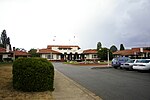Canberra Street Circuit
Former Supercars Championship circuitsMotorsport venues in the Australian Capital TerritorySports venues in CanberraUse Australian English from March 2018

The Canberra Street Circuit was a temporary street circuit located in Canberra, Australian Capital Territory, Australia. It hosted the Canberra 400 for the V8 Supercars series from 2000 to 2002.
Excerpt from the Wikipedia article Canberra Street Circuit (License: CC BY-SA 3.0, Authors, Images).Canberra Street Circuit
Langton Crescent, Canberra Parkes
Geographical coordinates (GPS) Address Nearby Places Show on map
Geographical coordinates (GPS)
| Latitude | Longitude |
|---|---|
| N -35.298611111111 ° | E 149.1275 ° |
Address
Langton Crescent
Langton Crescent
2600 Canberra, Parkes
Australia
Open on Google Maps









